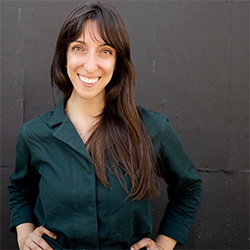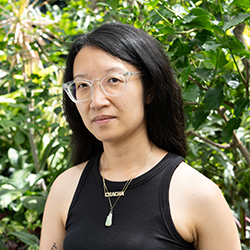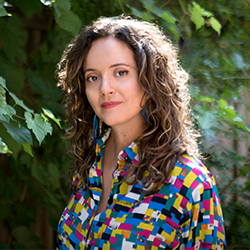2025 Theme & Artistic Team
Translating the City
Cities are living texts, continually shaped by histories, landscapes, architecture, infrastructure, nature and people. Their languages take many forms—spoken, written, visual, gestural and sonic—creating layered and ever-evolving individual and collective narratives. Cities also communicate through their built and natural environments, public spaces, rhythms and even in their silences.
For Nuit Blanche 2025, Translating the City interprets, transforms and decodes the urban experience through art. Inspired by the multilingual nature of cities, including Toronto, where over 200 languages are spoken, this theme considers the intersections of culture, language, identity and place. Translation is not simply the conversion of one language to another, but the connection and understanding it creates.
This year’s theme explores how art can translate the complexities of cities, inviting us to reconsider our role within them, and to reimagine the possibilities they hold.
About the Artistic Director
Laura Nanni (she/her) is a renowned curator, producer and artist with over 15 years of experience in large-scale events, performance and public art. She is widely recognized for her successful leadership and curation of initiatives focused on artistic experimentation, civic engagement and interdisciplinary collaboration. Most recently, Nanni served as Artistic Director for Nuit Blanche 2024. Prior to this, Nanni has held various roles including Artistic & Managing Director of SummerWorks (2016 to 2023); Interim Programming Supervisor for Nuit Blanche Toronto (2013 to 2015); Producer for Luminato Festival (2014 to 2015); Rhubarb Festival Director for Buddies in Bad Times Theatre (2010 to 2014); and Curator & Program Coordinator for HATCH mentorship and residency program at Harbourfront Centre (2008 to 2010). Her artworks and collaborations have been presented globally.

Meet the Curators & Learn About Their Exhibitions
About the Exhibition
Collective Composition considers how cities can translate into and be experienced as compositions. It asks us to contemplate our shared role in shaping our urban landscape and celebrates the notion that cities can provide something for everyone when they are created by everybody.
About the Exhibition
Poetic Justice brings together the multilayered histories of Toronto as Indigenous lands and city of arrival and departure. It considers concepts of land, treaties, justice and reform wherein the city is always in translation and its publics are continually mixing. The exhibition will also delve into ancient storytelling, language and music, offering viewers and listeners insight into what the city sounds like, and how we can all participate in making a soundtrack of our own.
About the Curator
Charlene K. Lau is an art historian, critic and Curator of Public Art at Evergreen Brick Works. Her research interests include art of the global Asian diaspora, the Gesamtkunstwerk in art and fashion, time-based media, and transgression. She has held fellowships at the Banff Centre for Arts and Creativity; Parsons School of Design, The New School; and Performa Biennial. Charlene has also held teaching positions at Parsons School of Design, OCAD University, Toronto Metropolitan University, University of Toronto Scarborough, Western University and York University. Her scholarly voice and curatorial work have been featured in The Guardian, PAPER, The Goods by Vox, The New Yorker and Studies in Costume & Performance; and her scholarly work has been published in Critical Studies in Fashion & Beauty, Fashion Theory, Journal of Curatorial Studies, The Routledge Companion to Fashion Studies (2021) and Visual Typologies from the Early Modern to the Contemporary: Local Contexts and Global Practices (Routledge, 2018). She has written art criticism for Art in America, Artforum, TheAtlantic.com, The Brooklyn Rail, C Magazine, Canadian Art and frieze, among others.

About the Exhibition
From here, there, everywhere highlights a version of any big city’s story: being a permanent or temporary home for millions of people. The works in this exhibition will translate the multiple meanings of home, a concept as complex as the many cultures that shape a city. What does it mean to feel both at home and displaced? Where is home when one can have so many of them – or none whatsoever? How are homes built and rebuilt?
About the Curator
Renata Azevedo Moreira (she/her) is a Brazilian author, researcher, and curator based in Tkaronto. Queer, feminist and postcolonial gestures inspire her curatorial practice, which focuses on collaboration and inclusivity by striving to create space for connections between QBIPOC artists in different stages of their careers.
Renata obtained a Ph.D. in Communication Studies from the Université de Montreal in 2021 with research focused on the entanglements between curatorial work and the creation of media artworks. She has worked as an Assistant Curator of Canadian Art at the Art Gallery of Ontario, as well as the Head of Cultural Affairs of Ireland in Canada. She has recently started research about artistic practices engaging in queer and decolonial joy as a form of resistance, with an upcoming digital residency at Esse magazine in Montreal.
Renata’s writing (English, French and Portuguese) has been published in art magazines such as Border Crossings and Esse; in cultural websites like the Montreal-based Baron Mag, where she had the monthly exhibition review column L’art au rendez-vous; and in the book Imagining Futures of Experimental Media (2021).



